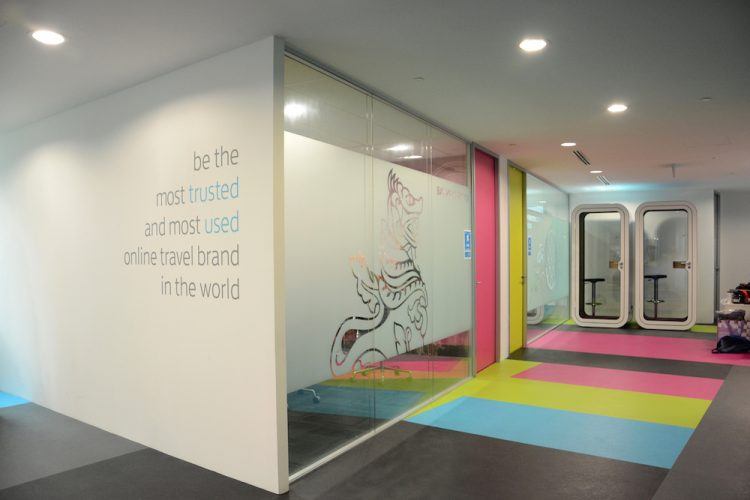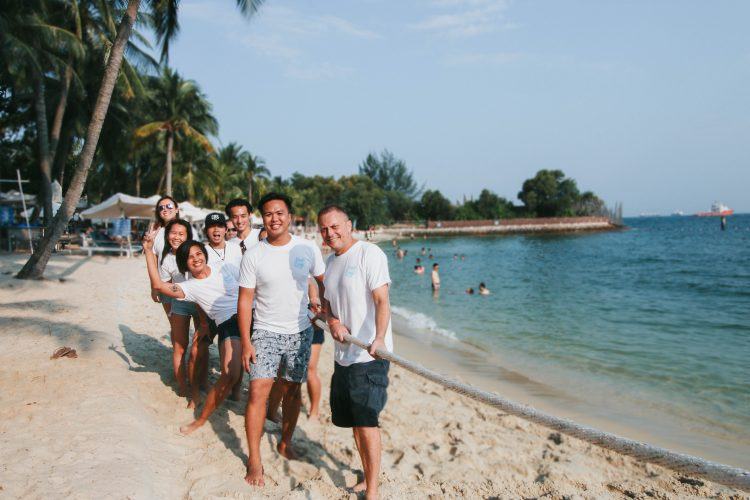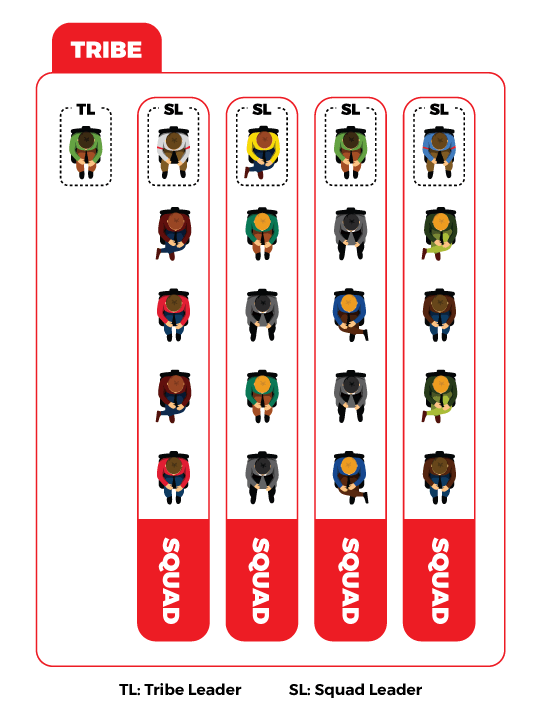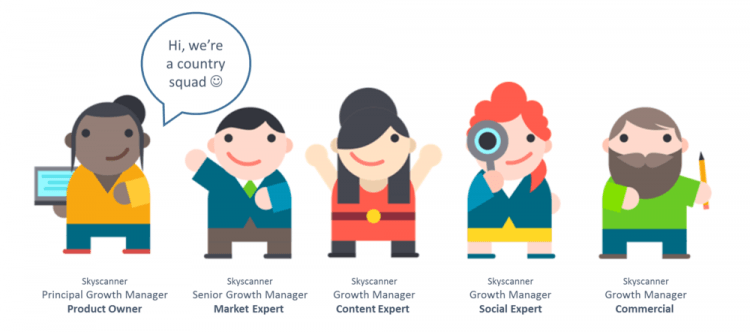The Inside series is a column where the Tech in Asia Jobs team gives an insider’s glimpse into interesting companies and professions. Looking for a job? Search thousands of jobs for free on Tech in Asia Jobs.
I immediately recognized the Skyscanner office upon stepping out from the elevator. Decked in its familiar blue, pink, green and grey theme, it looked exactly like every other Skyscanner office I’d seen online.

Photo credit: Skyscanner.
But unlike the others, Skyscanner’s Singapore office is their regional headquarters, and is where a lot of the magic happens to bring the UK brand to its Asia-Pacific counterparts. In Singapore alone, the team reports solid revenue growth and a 40 percent visitor growth year on year.
I spoke to Paul Whiteway, senior director and head of growth for Asia, to find out more about Skyscanner’s development in the region.
Skyscanner’s expansion to APAC

Members of the Skyscanner APAC team at an annual team bonding event this year. Whiteway is first from the right. Photo credit: Skyscanner.
Skyscanner landed on Singapore’s shores in 2011, when its business was picking up in Asia.
Since then, its Singapore office has flourished into a 100-strong team, including the Growth, Commercials, and Product teams — the three pillars that unlock growth in their markets.
“As the regional HQ, we have a very diverse team based in Singapore,” said Whiteway. “We have teams from the local countries who are responsible for growth in their markets. My job is to help them be successful. This involves managing and working with teams to help them define and execute the strategy for growth in our markets.”
“I act like a chef by finding the right recipe and mix for a market, coordinating the resources, timing the execution, getting the resources and ingredients, and removing blockers,” he added.
Organisational structure
Unlike traditional corporations, Skyscanner is organized into cross-functional teams or squads.

Image credit: Joshua Lim.
To put it simply, the APAC team in Singapore is called a tribe, with Whiteway as the tribe leader.
Within the APAC tribe, there are different kinds of squads, like the growth and engineering squads. Squads have between five to eight members.
Growth squads are typically organized by the countries belonging to the region they handle. For example, the Singapore office has the Korea squad, the India squad, the South Asia squad (in charge of Singapore, Malaysia and Thailand), the Oceania squad (in charge of Australia and New Zealand), and the VIP squad (in charge of Vietnam, Indonesia and Philippines).
In general, this is what a country squad looks like.

Image credit: Skyscanner.
This structure allows squads to work towards achieving the same key performance indicators together. As a result, teams are lean and agile, with complete autonomy to enable rapid iteration and have maximum impact.
Entering new markets
According to Whiteway, Skyscanner sets out “to build a sustainable foundation for growth,” beginning by “understanding the level of product-market fit for that market and some key critical growth levers.”
They then conduct some limited marketing activity to provide initial stimulus. This could be anything from running advertisements, improving search engine optimization, public relations activities, and blogger outreach.
Next would be finding ways to get to product-market fit.
“To determine product-market fit,” he said, “we use a set of key metrics, such as acquisition, activation, retention, referral and revenue [or AARRR] to consider whether the market has the potential to support growth.”
“Product-market fit is always a moving target for us,” he said. “Take Korea for example. At the initial stages, it was crucial to get local partners and airlines into Skyscanner. Once that was in place, Skyscanner Korea was able to offer local currency options and local support. As it progressed, it was learning how travellers book and make choices, and then adjusting the product to match that.”
Once they get to product-market fit, Skyscanner then applies certain growth levers, such as increasing the number of local partners, app store optimization, and running advertisements and email marketing campaigns.
“We are also always tweaking our product to make sure product-market fit remains,” he said.
Challenges of localisation
“The fact that APAC isn’t as homogenous a region like Europe is both an opportunity and challenge for us,” said Whiteway. “We needed to make sure we are adapting our offering to individual Asian markets while making our business more nimble and responsive to customer needs.”
He also cited the allocation of resources as a constant challenge.
“In some markets, we need to take a leap of faith in order to kickstart growth,” he said. “In others, the small experiments and iterations will prove more successful and effective. Our teams are constantly looking into the data, speaking to users, and working across different squads and tribes, in order to determine what the right approach is.”
Case study: Korea

The Korea squad. Photo credit: Skyscanner.
Whiteway held up Skyscanner’s Korea squad as a huge success.
“The team has managed to grow more than double year-on-year and has hit its first revenue milestone in January of this year,” he said.
He pointed out several elements that have worked in their favor.
“At the beginning, the squad focused on building supply by speaking to airlines and educating them about Skyscanner. With the help of engineers, we were able to integrate partners such as Korean Air and Asiana Airlines within a year. Having local partners on Skyscanner provided users with locally available prices, familiar brands, and local customer services,” he said.
However, technical problems occurred when the airlines’ systems proved incompatible with Skyscanner’s, affecting the accuracy of prices presented on Skyscanner.
“This affected the user experience and was a challenge for us to move forward,” he said. “Our engineers worked closely with the product, commercial, and growth teams to help stabilize the system and improve price inaccuracies. That helped our brand earn the trust of the Korean travelers.”
Once the issue was resolved and they found product-market fit, the growth teams were able to execute and optimize marketing activities to acquire and retain users.
“Our squads and tribe structure helped see collaboration among the product, commercial, and growth teams to overcome such challenges. And it has proven successful for us,” he said.
Areas for improvement
Despite its successes, Whiteway still sees areas where Skyscanner can do better.
“APAC consumers have different purchasing behaviours, and they access the internet from their mobile devices more so than on their desktops,” said Whiteway.
“Our app usage is climbing towards 50 percent, but we are not there yet,” he continued. “We are now working towards that direction and want to be able to move our app usage to 80 percent, like our parent company, Ctrip.”
Hiring

The Skyscanner Oceania squad. Photo credit: Skyscanner.
Whiteway said Skyscanner is looking for people who are not only collaborative and independent, but are also active learners and self-starters. “Because of the way we are structured as a growth organisation, we are looking for talent with T-shaped skillsets — those who are willing to explore and learn skills beyond their own specialization,” he said.
He also shares some helpful advice for potential candidates.
“Be data-driven and experimental. Build, measure and learn. Design like you’re right, and test like you’re wrong,” he said.
This post How Skyscanner enters new markets appeared first on Tech in Asia.
from Tech in Asia https://www.techinasia.com/how-skyscanner-enters-new-markets
via IFTTT
No comments:
Post a Comment